An ND filter is like sunglasses for your lens. It helps you manage the light hitting the sensor without adjusting ISO, shutter speed or aperture.
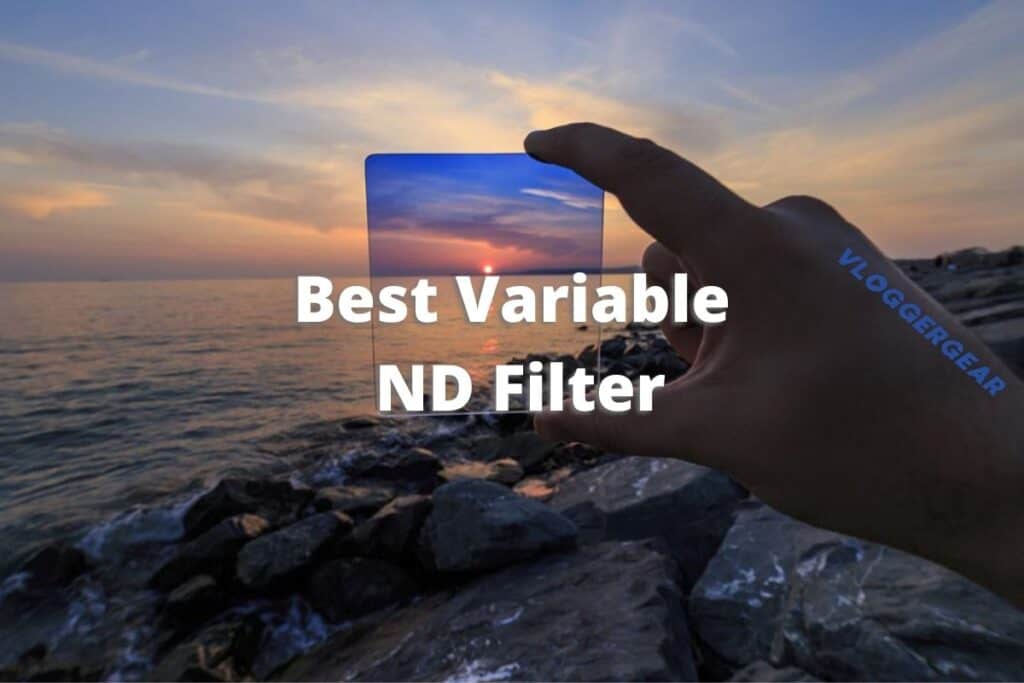
The higher the stops mentioned in the filter, the more the filter’s light stopping power. I.e., the more it will cut out light. But a variable ND filter goes a step further. It comes with an outer ring that you can turn and change the amount of light that goes through.
At this point, you must be wondering, “why would I want to cut out light in the first place?” The simple reason is that too much light can sometimes be a problem, especially when you want to do creative photography, such as when you want to photograph a waterfall or capture motion blur in your images.
Today, I am going to discuss the best variable ND filters that you can buy right now.
Quick Tip: Finding the Perfect Filter Size
The lens front element has small prints indicating a lot of things about the lens. Look for this symbol – Φ followed by a number like 58 or 62 or 67 or 77 followed by the letters mm. This is the size of the filter that will fit your lens.
If you are using a step-up or step-down ring, make sure that one side fits the specification mentioned on the front element of the lens – as explained above – and the other side fitting the specification of the filter (This applies only when you are using a step-up or step-down ring).
These accessories are almost imperative for modern cameras and YouTubers. Like a gimbal, tripod or good lighting equipment, this is only a piece of the puzzle that makes your videos look great.
2022’s Top 5 Variable ND Filters for YouTubers, Vloggers and Filmmakers
- Tiffen Variable ND Filter
- PolarPro 82mm Peter McKinnon Edition II
- Hoya 77mm Variable Neutral Density Filter
- Gobe 2 Peak Variable ND filter 72mm
- B+W 77mm XS-Pro Digital ND Vario MRC-Nano Filter
1. Tiffen Variable ND Filter
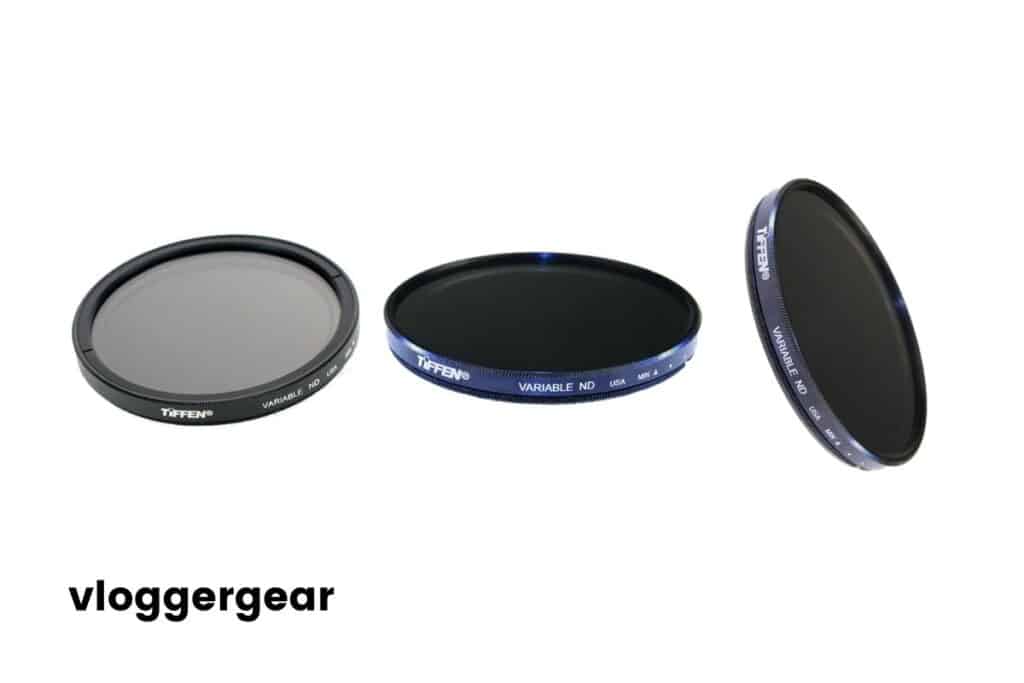
Best use case
For shooting motion blur in broad daylight, flowing water, waterfalls, seascapes, for portraits with a wide-open aperture.
Specs
- A light stopping range of 2 stops to 8 stops.
- Works with both film and digital cameras.
- The aluminum filter ring is capable of handling some abuse.
- The wide outer ring ensures better vignette control.
- Made out of ColorCare Glass
- Made in the USA
- Comes in 52mm, 58mm, 62mm, 67mm, 72mm, 77mm, and 82mm.
Review
The Tiffen variable ND filter is a premium product. It is widely used by photographers and cinematographers worldwide.
This variable ND filter has a wide range of light stopping power: from 2 stops to 8 stops. That means one variable ND filter does the job of many. That also means you don’t have to carry several different filters every time you head outdoors.
You can experiment with a wide aperture lens and shoot with a wide-open aperture in broad daylight. You can experiment with a shallow depth of field by using a wide-open aperture that would otherwise be impossible to achieve in broad daylight.
Of course, variable ND filters (and ND filters) are known for their ability to keep the shutter open for a long time. That means you can experiment with long exposures, motion blur, and stuff.
The fact that this variable ND filter comes in all the popular filter thread sizes means you will find one matching your favorite lens.
2. PolarPro 82mm Peter McKinnon Edition II
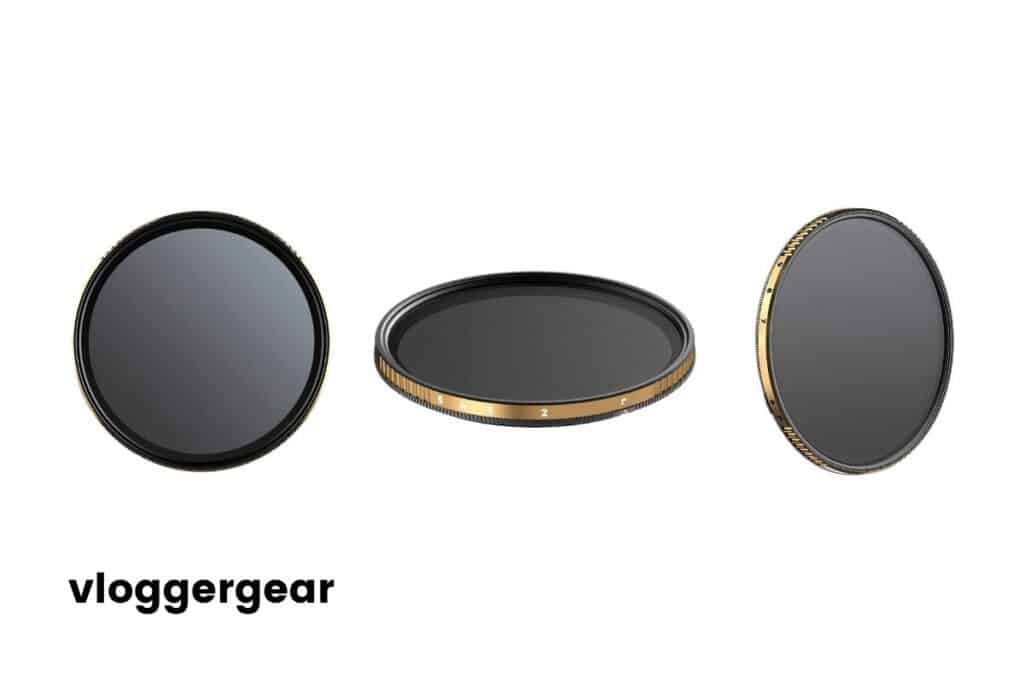
Best use case
This filter is ideal for inducing motion blur in your images. You can shoot waterfalls with this, as well as seascapes.
Specs
- Variable ND filter with light stopping power from 2 stops to 5 stops.
- The front element has been treated to resist water, oil, and fingerprints.
- Scratch-resistant.
- Multi-coated
Review
If you are looking for a premium quality variable ND filter for your high-quality lens, chances are that you might have looked at the PolarPro series.
However, this particular 82mm variety is perfect for several landscape lenses. 82mm is a large filter thread, and it fits some of the premium landscape photography lenses from the top three manufacturing companies.
The Nikon AF-S NIKKOR 24-70mm f/2.8E ED VR and the latest Nikon NIKKOR Z 14-30mm f/4 S lens (designed for the Z mount system).
If you are a Canon user, this filter will match the thread specification on your Canon EF 16-35mm f/2.8L III USM, Canon EF 16-35mm f/2.8L II USM, and the Canon EF 24-70mm f/2.8L II USM lenses.
On the Sony side, this filter will work with the Sony FE 16-35mm f/2.8 GM and the Sony FE 24-70mm f/2.8 GM lenses.
The 2 to 5 stops of light stopping power makes this a versatile filter for several photographic situations. You can push the shutter speed down to a second, depending on the ambient lighting conditions. So, a motion blur effect of a waterfall or someone moving in the frame as the exposure is being made is ideal case scenarios.
That said, this filter will not be sufficient where the conditions are too bright and you are using a high-speed lens. Sadly, the five stops of light stopping power will not cut it.
3. Hoya 77mm Variable Neutral Density Filter
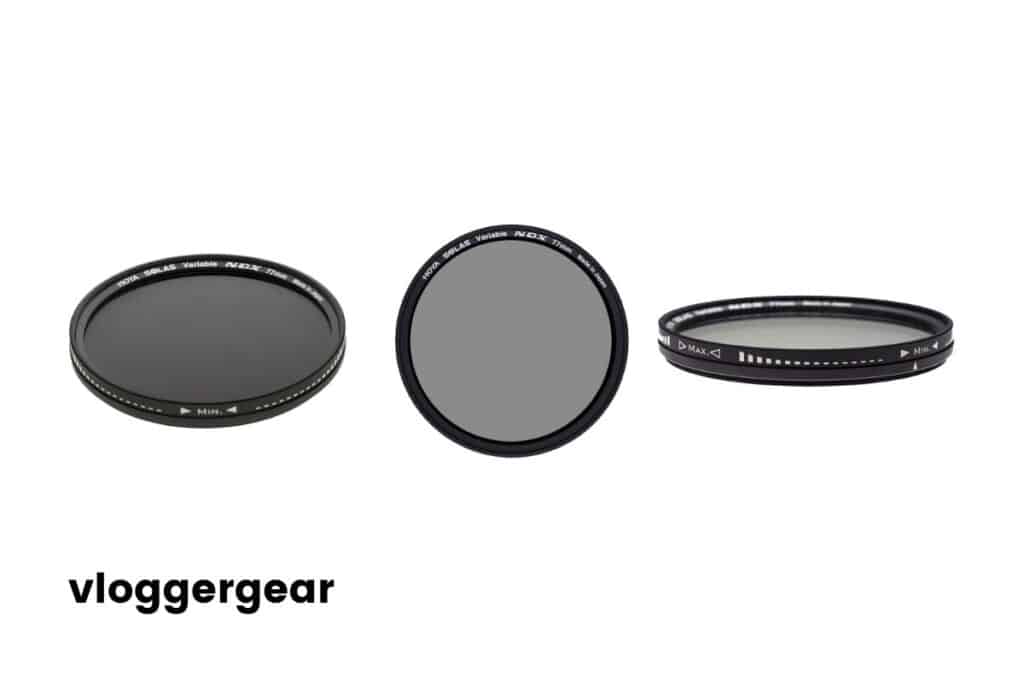
Best use case
Hoya is a reputed brand. Their ND filters, C-PLs, and Variable ND filters are some of the best in the industry.
This filter is suitable for much of the same purposes listed above.
That said, the extra one stop of light stopping power (up to 9 stops) ensures that you have a bit more flexibility, making it one of the best variable ND filters for video shooting.
Specs
- 1.5 stops to 9 stops of light stopping power.
- At nine stops, the image is completely darkened, and only a long exposure can properly expose the frame.
- Optical glass-made construction.
- The outer ring is made of slim aluminum construction.
- Slim construction of the outer ring also has the effect of reduction in vignetting.
Review
This particular variable ND filter has a light stopping power of 1.5 stops to 9 stops. That means it is more powerful than the PolarPro 82mm Peter McKinnon Edition II. Making it one of the best variable ND filters in the market right now.
This filter is suitable for use in bright sunlit conditions for long exposures with a fast lens. Things like waterfalls, seascapes, motion blur in bright daylight are some of the possibilities with this lens.
It is also suitable for capturing the breathtaking shallow depth of field, which is impossible to achieve without an ND filter in bright light.
Like some of the other variable ND filters that we have discussed here, the Hoya comes with a slim profile outer ring that prevents the possibility of vignetting.
77mm is a bit more popular when compared to 82mm, which is quite large. There are a bunch of lenses from all the three leading brands that conform to that filter thread specification.
Nikon’s AF-S NIKKOR 16-35mm f/4G ED VR, the AF-S DX NIKKOR 10-24mm f/3.5-4.5G ED that is designed for the smaller image circle of DX-format cameras, and the AF-S Zoom-NIKKOR 17-35mm f/2.8D IF-ED, also designed for the smaller image circle DX cameras.
Among the popular Canon lenses that support a 77mm variable ND filter are the EF 24-105mm f/4L IS USM and the EF-S 10-22mm f/3.5-4.5 USM – which is designed for the smaller EF-S mount.
4. Gobe 2 Peak Variable ND filter 72mm
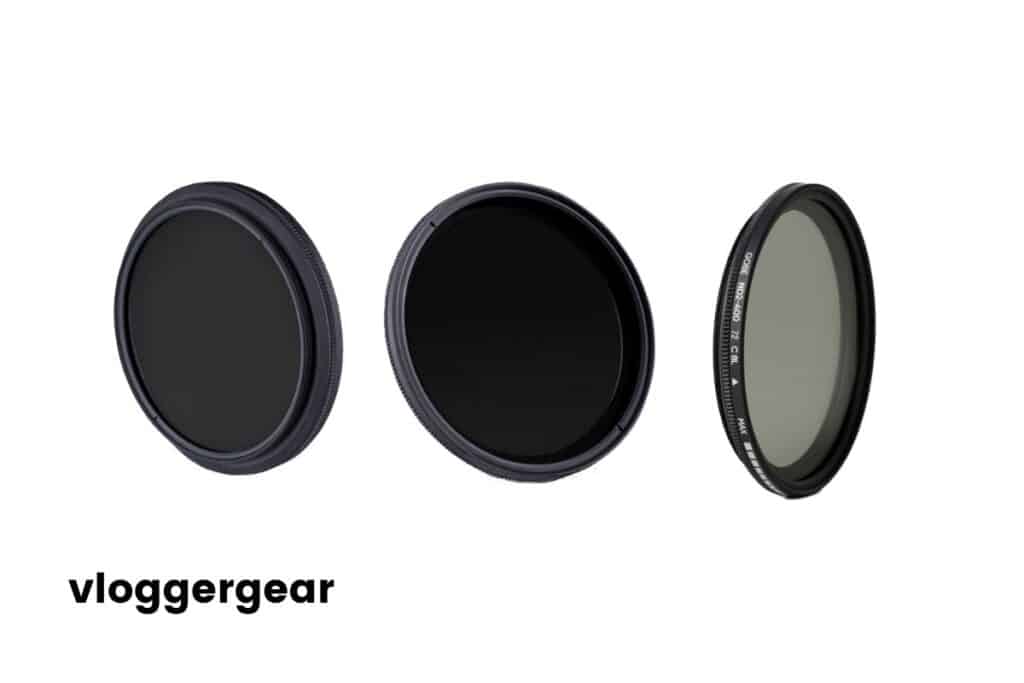
Gobe makes a bunch of affordable ND and variable ND filters, among other items. They are more reasonably priced than the other brands like B+W, Tiffen, and Hoya. We pick the 72mm version of this filter for this list, though you will get all the options from 37mm to 86mm.
Best use case
The Gobe can reduce the exposure by one stop to 8.65 stops. That’s not the best but is still very good considering the price.
Ideal use cases are again landscapes, waterfalls, motion blur, and related stuff. Also great for shooting videos with a wide aperture lens.
Specs
- It reduces exposure from 1 stop to 8.65 stops.
- The outer ring is made out of magnalium-alloy. It is stronger than aluminum but is lighter.
- Optical glass construction.
- 77mm filter thread specification.
Review
Gobe manufactures a wide variety of filters, among which are their variable neutral density filters. Compared with the ones I have listed above (Hoya, PolarPro, and Tiffen), Gobe is a lot cheaper.
Gobe uses magnalium-alloy filter rings, which are much stronger than aluminum and yet lighter.
Inside the actual filter is an optical glass construction for optimum efficiency.
The one stop to 8.65 stops of light-blocking power is sufficient for most practical reasons. If you need an additional amount of light stopping power, I recommend looking at a regular 10-stop ND filter.
The filter thread specification is 77mm, which supports a vast number of lenses. This includes the Sony FE 16-35mm f/2.8 GM and the FE 24-70mm f/2.8 GM. Both of these lenses are designed for Sony’s mirrorless units.
A bunch of Nikon lenses are also supported. Among them are many fixed focal length lenses like the Nikon AF NIKKOR 20mm f/2.8D, the 24mm f/2.8D, the 28mm f/2.8D, and the 35mm f/2D.
All of the above lenses are old designs, but they are still useful for landscape photography.
Among the newer generation lenses, this filter will work on a personal favorite of mine: the AF-P DX NIKKOR 10-20mm f/4.5-5.6G VR as also on a venerable kit lens – the AF-P DX NIKKOR 18-55mm f/3.5-5.6G. Both of these lenses are designed for smaller DX Nikon cameras.
5. B+W 77mm XS-Pro Digital ND Vario MRC-Nano Filter
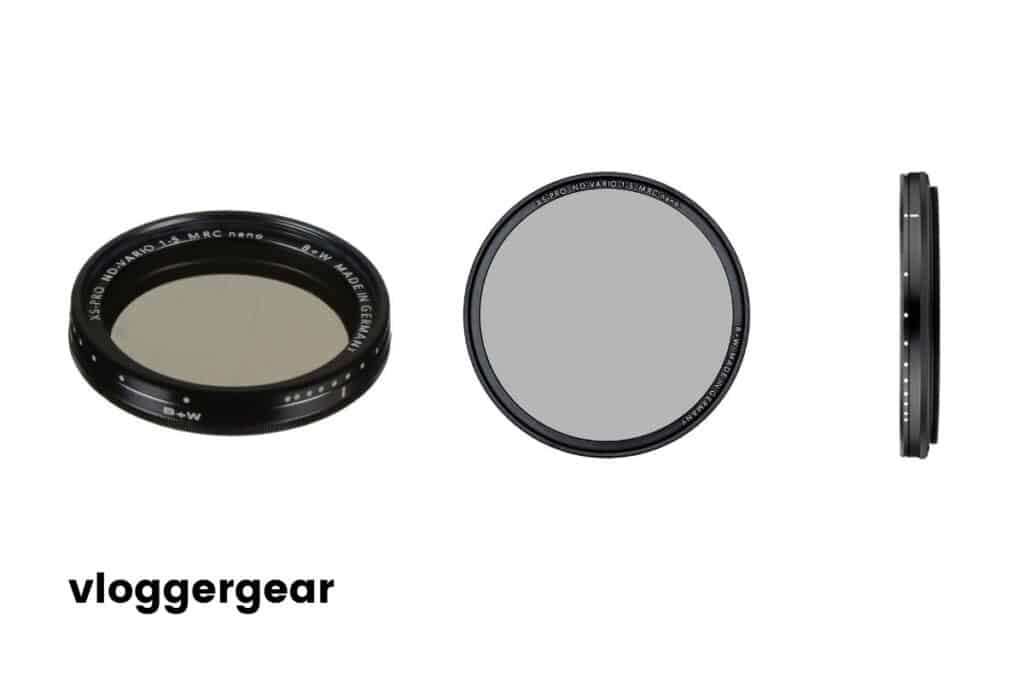
Best use case
B+W’s 77mm variable ND filter is best used to shoot long exposure photos/videos in daylight. There are a ton of other situations when this filter will find itself sought after. Waterfalls, seascapes, motion blur in sunlight, capturing the shallow depth of field, and so on.
Specs
- Variable ND filter from 1 stop to 5 stops.
- Allow you to use a shutter speed that is up to 5 stops slower than you can normally use.
- It comes with a Multi-Resistant Coating to prevent scratches as well as prevent reflections.
- Thin profile for suppressed vignetting.
Review
The B+W 77mm XS-Pro Digital ND Vario MRC-Nano offers you a variable light stopping power from 1 stop to 5 stops. Five stops will work in most working situations for producing shallow depth of field when using a wide-open aperture in broad daylight or for capturing motion blur by dragging the shutter release.
But five stops may not be enough for capturing something more creative such as flowing water.
The filter comes with a multi-resistant coating that ensures that the front element can resist scratches and abrasion, preventing reflections from affecting the images’ quality.
An exciting departure from the traditional designs in the above filters is the presence of an 8th layer. Thanks to the Nano coating. This produces an interesting beading effect that helps to clean the filter easily compared to other filters.
Additionally, the filter uses Schott glass which ensures that the filter has a thin profile, improved optical clarity and color reliability, and suppressed vignetting.
FAQ
Are Variable ND Filters Any Good?
Variable ND filters are a great piece of tool. If you are a landscape photographer who loves shooting long exposures in broad daylight and experimenting with fast apertures in broad daylight, you cannot do without a variable ND filter.
How do Variable ND Filters Work?
Variable ND filters are two pieces of glass placed one in front of the other. These are two separate circular polarizing filters sandwiched together.
The inner layer accepts light coming in from one orientation. When you turn the outer ring, the two rings block an increasingly higher amount of light. This continues till you have a situation where the exterior and the inner rings are aligned and block the maximum amount of light.
Which Brand of ND Filter is the Best?
The quality of the glass is the primary thing that you should consider when choosing an ND filter. Make sure that it does not cast any color on your images. Make sure that there are no aberrations. Tiffen, Hoya, and B+W are some of the best brands of ND filters.
What is the Process to Use an ND Filter?
Make your composition before mounting the filter. It is also necessary to lock your focus before you mount the variable ND filter and meter for the shot. Once composition, metering, and focusing are done, mount the variable ND filter.
Depending on the exposure duration, you can adjust the variable ND filter to its appropriate strength. Now drag the shutter speed so that you can compensate for the loss in the amount of light.
Let’s take an example.
Let’s say that you meter a scene at f/8 and ISO 100 at 1/250 of a sec. You now mount a variable ND filter and set it to 8 stops. What would be the correct shutter speed to maintain the same exposure as you metered above? The answer is 1 second.
How the heck did I come up with that number? Well, you can simply refer to a shutter speed chart that lists all incremental shutter speeds at a gap of one stop. Or you can download a simple exposure chart, fill in the details, and it will give you the ideal shutter speed.
These are the best variable ND filters in 2022. We hope this helped you understand a bit more about filters, sizes and how to use these pieces of vlogging gear. If you are a filmmaker, YouTuber or vlogger, having a quality neutral density filter that lasts you a long time is super important.

BK says
Good write-up. It would’ve been even better if you reviewed Urth’s ND as well.